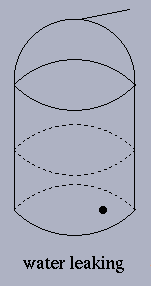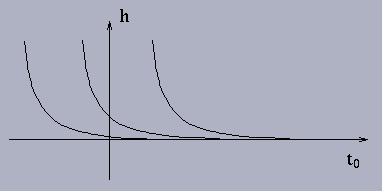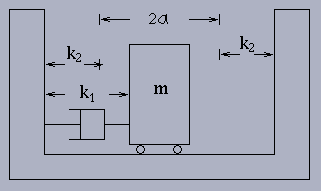Theorem 3.2.1: Let
In this section, we consider the nonlinear systems of
ordinary differential equations
Theorem 3.2.1: Let ![]() be an open
subset of Rn and assume that
be an open
subset of Rn and assume that
![]() .
Then
.
Then
![]() such that the IVP
such that the IVP
Proof: (omitted)
Remark 1: If the assumption f being
C1 is replaced by f being C0,
the IVP (3.6) can still have existence which is
guaranteed by Peano's theorem, but uniqueness may fail to
hold. For example, the IVP
![]() ,
x(0) = 0 has solutions
,
x(0) = 0 has solutions
![]() and
x
(t) = t3, and in fact, it has infinitely many
solutions. Note that
and
x
(t) = t3, and in fact, it has infinitely many
solutions. Note that
![]() is
continuous but not C1. The following practical
example is very interesting.
is
continuous but not C1. The following practical
example is very interesting.
Example 3.2.1: Leaky bucket problem
h(t) - water level (height) remaining in the bucket at time t.
A - area of the cross-section of the bucket,
a - area of the cross-section of the hole,
v(t) - velocity of the water leaving the hole.
Then

Assume no energy loss:
![]() ,
,
![]() ,
,
![]() -density
-density
Q: If at a given time, you see the bucket
empty, can you figure out when it is (if ever) full?

Clearly, the IVP
Remark 2: From the proof of Theorem 3.2.1, we
see that the condition f being C1 can be
replaced by f being Lipschitz, namely, there
exists L > 0 such that
Example 3.2.2: Consider a piecewise-linear
oscillator shown below. (Dynamics & Stability of Systems,
Vol. 6, P. 51, 1991)
The restoring force Fr is given by

Thus the motion of the mass m is governed by

By Theorem 3.2.1, if
![]() ,
then
,
then
![]() the IVP (3.6) admits a
unique solution x(t) defined on
the IVP (3.6) admits a
unique solution x(t) defined on
![]() for some
for some
![]() .
But the number
.
But the number
![]() is, in general, very small. Thus Theorem 3.2.1
is often referred to local result. Naturally, we are
interested in the existence of a solution x(t) of
the IVP (3.6) defined on an interval as large as
possible. This can be realized by extending the solution
x(t) to both sides of the interval
is, in general, very small. Thus Theorem 3.2.1
is often referred to local result. Naturally, we are
interested in the existence of a solution x(t) of
the IVP (3.6) defined on an interval as large as
possible. This can be realized by extending the solution
x(t) to both sides of the interval
![]() .
The idea is as follows: since x(t) is
defined on
.
The idea is as follows: since x(t) is
defined on
![]() ,
the point
,
the point
![]() .
Then apply Theorem 3.2.1
to get an extension of x(t) on
.
Then apply Theorem 3.2.1
to get an extension of x(t) on
![]() .
.
![]() continue. Extension to right
proceeds
continue. Extension to right
proceeds
![]() .
Similarly, proceed to left:
.
Similarly, proceed to left:
![]() .
The limits
.
The limits
![]() and
and
![]() ,
where Pm tends to the boundary of
,
where Pm tends to the boundary of ![]() as
as
![]() .
In general, we have the following
definition.
.
In general, we have the following
definition.
Definition 3.2.1: Let x(t) be a
solution of the IVP (3.6) defined on an interval J.
Then J is called a right-maximal interval of
existence for x(t) if there does not exist an
extension of x(t) over an interval J1 so
that
x(t) remains a solution of the IVP (3.6) on
J, and J is a proper subset of J1
with different right endpoints. A left-maximal interval of
existence for x(t) can be defined similarly. A
maximal interval of existence for x(t) is an
interval which is both a left-maximal and right-maximal
interval.
The next theorem is an immediate consequence of the above discussion.
Theorem 3.2.2: Let ![]() be an open
subset of Rn and assume that
be an open
subset of Rn and assume that
![]() and let x(t) be a solution of the IVP
(3.6) for
and let x(t) be a solution of the IVP
(3.6) for
![]() on some interval.
Then x(t) can be extended over a maximal interval
of existence
on some interval.
Then x(t) can be extended over a maximal interval
of existence
![]() .
Moreover, if
.
Moreover, if
![]() is a maximal interval of
existence, then x(t) tends to the boundary of
is a maximal interval of
existence, then x(t) tends to the boundary of
![]() as
as
![]() and
and
![]() .
.
Remark: There is no guarantee that a solution
x(t) to an IVP can be defined for all ![]() .
.
Example 3.2.3: The IVP
We usually say that such a solution has a ``finite escape
time''.
The following corollaries of Theorem 3.2.2 are very useful in applications.
Corollary 3.2.1: Let f(x) be
continuously differentiable on Rn and x(t) be a solution of (3.6) on a maximal right (left)
interval J. Then either
![]()
![]() or
or
![]()
![]() with
with
![]()
![]() and
and
![]() at
at
![]() .
.
Corollary 3.2.2: Let f(x) be
continuously differentiable on Rn and x(t) be a solution of (3.6) on a maximal interval J.
Then
![]() if one of the
following is true:
if one of the
following is true:
Example 3.2.4: Consider the hard spring again
Exercise 3.2.1: Show that all solutions of the
piecewise-linear oscillator considered in Example 3.2.2 are
uniquely defined on
![]() .
.
Example 3.2.5: Consider the population growth
model
Clearly, the right-hand side of (3.9) is of C1
on R2. From (3.9), one can see that for x,y
> 0 sufficiently large (in fact x,y > 2 is
sufficient) we have

As you saw in Example 3.2.3 there are solutions that have ``finite escape time''. That is, a solution of a differential system is only defined on a finite interval. Intuitively, we may be able to eliminate this possibility by slowing down the motion, which is precisely the following result.
Theorem 3.2.3: Let f(x) be
C1
(Rn) and
 .
Then all solutions of the IVP
.
Then all solutions of the IVP
Proof: (omitted)
Remark: The function
![]() can be
chosen to be any positive function on Rn. The idea
is to rescale the vector field without changing its
direction and consequently the orbits are unchanged.
Intuitively,
can be
chosen to be any positive function on Rn. The idea
is to rescale the vector field without changing its
direction and consequently the orbits are unchanged.
Intuitively,
![]() has the effect of
``slowing down'' the state point x, so that it
cannot ``escape to infinity'' in a finite time.
has the effect of
``slowing down'' the state point x, so that it
cannot ``escape to infinity'' in a finite time.
Exercise 3.2.2: Show that all solutions of the
IVP
